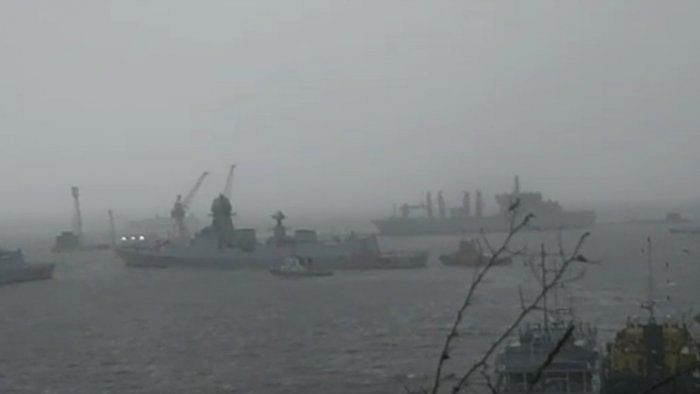
A deep depression over Lakshadweep islands on May 14 turned into Cyclone ‘Tauktae’, ravaging the coastal areas of Kerala, Karnataka, Goa, Maharashtra on its way to finally making landfall in Diu and Gujarat on May 17/18, packing ferocious winds, pounding rains and severe destruction of buildings, roads, electric poles and trees along the way. Some 30 people have perished in the three day-long fury. The cyclone has also sunk an oil-industry barge leaving 273 personnel adrift off Heera Oil Fields in Bombay High. Despite a 24-hour-long rescue operation, 91 people are still missing. The more rapid warming of the Arabian Sea as compared to the Bay of Bengal results in more frequent and destructive cyclones on India’s west coast.
In February 1991, the central government declared coastal stretches of seas and waterbodies influenced by tidal action up to 500 metres from the high tide line and the land between low tide line and high tide line as Coastal Regulation Zone (CRZ). However, the distance is restricted to 100 meters or width of the creek, whichever is less in case of tidal influenced waterbodies connected to sea. Prior approval of Coastal Zone Management Authority (CZMA) was made mandatory for any construction in CRZ. The reason behind the move was livelihood security of the communities in coastal areas, and to address the dangers of natural hazards and sea-level rise due to global warming.
Sometimes the courts ordered demolition of structures built in violation of CRZ notification. The most recent among these is the demolition of residential high-rise buildings in Ernakulum. Apartments built illegally, in violation of CRZ norms, at Maradu municipality, Ernakulum district, Kerala, were ordered to be demolished by the Supreme Court on May 8, 2019. The court observed that CRZ notification is meant to protect the environment and bring about sustainable development. The judges said that the violations should not be taken lightly; the law of the land must be obeyed and enforced.
The Ministry of Environment, Forest & Climate Change (MoEFCC) on February 19 dealt with cases where CRZ clearance had not been obtained. The ministry’s official memorandum said that the activities which are otherwise permissible and have commenced construction/operation without clearance would be considered for prospective clearance if the proponent approaches CZMA, who in turn assesses environmental and ecological damages and lists mitigation measures through ‘Compensatory Conservation Plan’ (CCP) and ‘Community Resource Augmentation Plan’ (CRAP) to be implemented within three years of grant of approval. With the CZMA’s recommendation, the ministry would refer the application for clearance to ‘Expert Appraisal Committee’, who would examine the adequacy of CCP and CRAP. Generally, unscrupulous builders, powerful hotel owners and violators manipulate clearances.
Unauthorised constructions in prohibited areas built by damaging natural sand dunes, by filling up river beds and lakes and also in no-development zones, eco-sensitive zones and on the seaward side of existing roads are rampant. Natural reserves of underground drinking water resources and the areas within high tide line are also not spared, in blatant violation of CRZ norms and building regulations. Damage to natural sand dunes, waterbodies and beaches cannot be mitigated through CCP.
The Forest Survey of India report of 2019 suggests that while Gujarat, Maharashtra and Odisha have added mangroves, Tamil Nadu, West Bengal and Andaman & Nicobar Islands have lost them. The area under mangroves in Karnataka is stagnant. Karnataka has been planting mangrove species in the coastal belt regularly. The department must investigate why mangrove plantations are not adding to the forest cover. The only inference is that mangroves are being destroyed at the same pace that they are being planted.
The National Green Tribunal’s committee recently visited a housing project in the coastal area of Kakinada (Andhra Pradesh) and found 30% of 116 acres of mangrove has already been destroyed. The Collector of the district justified the project saying that the mangroves were not notified forests and the government was moving to bring down its status from CRZ I to CRZ II. No construction is permissible in CRZ I areas. Should such manipulation be allowed, given that mangroves have complex root systems efficient in dissipating sea wave energy and protecting coastal areas from tsunamis, storm surges and soil erosion?
Frequent droughts, floods, landslides, cyclones, etc., in Kerala, Karnataka, Maharashtra and Gujarat indicate change of land use patterns in coastal belts and deforestation in Western Ghats. The construction of the coastal highway connecting Greater Mumbai and the bullet train project is destroying mangroves. If it is not arrested, cyclones like last year’s ‘Nisarga’ and ‘Tauktae’ will wreak greater damage the next time around.
With an eye on reviving the Covid-ravaged economy, the central government has opened the floodgates for grant of prospective CRZ clearances to regularise illegal constructions, which were otherwise to be demolished. The ease of doing business through this relaxation will invite cyclones like ‘Tauktae’ to cause greater damage and bring untold human misery.
(The writer is a former Principal Chief Conservator of Forests, Karnataka)